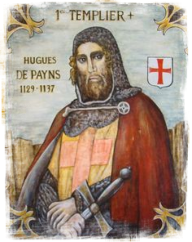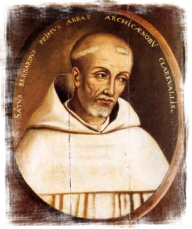
The
Order
was
founded
in
about
1118
to
protect
the
pilgrim
routes
and
Christian
communities
in
the
Holy
Land.
This
was
known
as
Outremer
–
the
kingdom
“beyond
the
sea”.
Under
their
first
Grand
Master,
Hugues
de
Payens,
the
Order’s
members
were
originally
known
as
the
Poor
Knights
of
Christ
and
took
monastic
vows
of
poverty,
chastity
and
obedience.
Recognising
their
valuable
role
as
champions
and
defenders
of
Christendom,
King
Baldwin
II
of
Jerusalem
granted
them
for
their
headquarters,
the
buildings
which
were
then known as the Temple of Solomon, on Temple Mount in the heart of Jerusalem – and as an obvious result they soon became known as the Order of the Temple of Jerusalem.
These
Templars
were
men
of
war
and
of
prayer
–
“Warrior
Monks”
–
and
such
was
their
fame
that
Abbot
Bernard
of
Clairvaux,
founder
of
the
Cistercian
Order
and
one
of
the
foremost
Christian
scholars
of
his
age,
wrote
a
book
in
support
of
the
Templars,
entitled
“In
Praise
of
the
New
Knighthood”.
Bernard
also
gave
the
Templars
their
new
Rule
under
which
they
were
to
lead
their
lives
and
advance
the
Christian
cause.
Each
Templar
was
to
be
loyal
to
the
Order
–
and
the
courage,
discipline
and
military
achievements
of
these
warrior
monks,
each
wearing
a
distinctive
white
mantle
with
a
red
cross,
earned
them
the
respect
and
admiration
of
all
Christendom.
By
the
middle
of
the
twelfth
century
the
Order
had become a major force both in the Holy Land and Europe, and was answerable only to the Pope.
For
two
hundred
years
this
religious-military
Order
fought
for
Christianity
wherever
it
was
threatened
–
establishing
fortress
strongholds
and
winning
many
battles.
Invariably
the
Templars
were
in
the
vanguard
of
the
Crusader
armies,
and
the
Order’s
supporters
and
admirers,
included
none
other
than
King
Richard
I
of
England,
“the
Lionheart”.
But
whilst
they
were
formidable
warriors,
the
Templars
were
as
much
respected
for their zeal and dedication to God as for their bravery or military prowess.
By
the
fourteenth
century
–
whilst
members
of
the
Order
still
lived
modestly,
according
to
the
strict
Rule
given
to
them
by
St
Bernard
of
Clairvaux
–
the
Order
itself
had
become
immensely
powerful
and
rich.
Its
influence
extended
not
merely
to
religious
or
military
affairs
but
to
finance
and
commerce
too.
It
was
the
Order’s
wealth
and
power
that
attracted
the
envy
of
others,
and
in
1307
the
French
king,
Philip
the
Fair,
had
all
the
Templars
in
France
rounded
up,
accused
of
heresy
and
imprisoned.
Philip
had
taken
several
large
loans
from
the
Order
in
Paris
but
was
broke
and
unable
to
repay
them.
He
persecuted
the
Jews,
confiscated
all
their
wealth
and
property,
and
then
set
his
eyes
on
the
alleged
Templar
treasure,
reputed
to
be
in
their
treasury
in
central
Paris.
However,
word
had
been
leaked
of
his
plan
to
arrest
all
Templars
at
dawn
on
Friday
13
October
1307
(hence,
the
‘unlucky’
“Friday
the
Thirteenth”),
and
most
of
the
Templars
had
already
left
the
city,
sailing
with
the
Templar
fleet
that
was
anchored
at
La
Rochelle
and
when
the
treasury
was
broken
into
it
was
found
to
be
empty
apart
from
a
few
pieces
of
furniture.
The
treasure,
if
it
ever
existed,
vanished
and
has
never
been
seen
again.Many
were
tortured
to
force
them
to
make
false
confessions.
These
arrests
were
made
in
the
early
hours
of
the
morning
on
Friday
13th
October
–
hence,
the
'unlucky'
“Friday
the
Thirteenth”.
The
confessions
of
heresy,
though
obtained
through
torture, led the Pope, Clement V, under further pressure from King Philip, to disband the Order in 1312.


© The Grand Priory in England of the Knights Templar, 2023






















